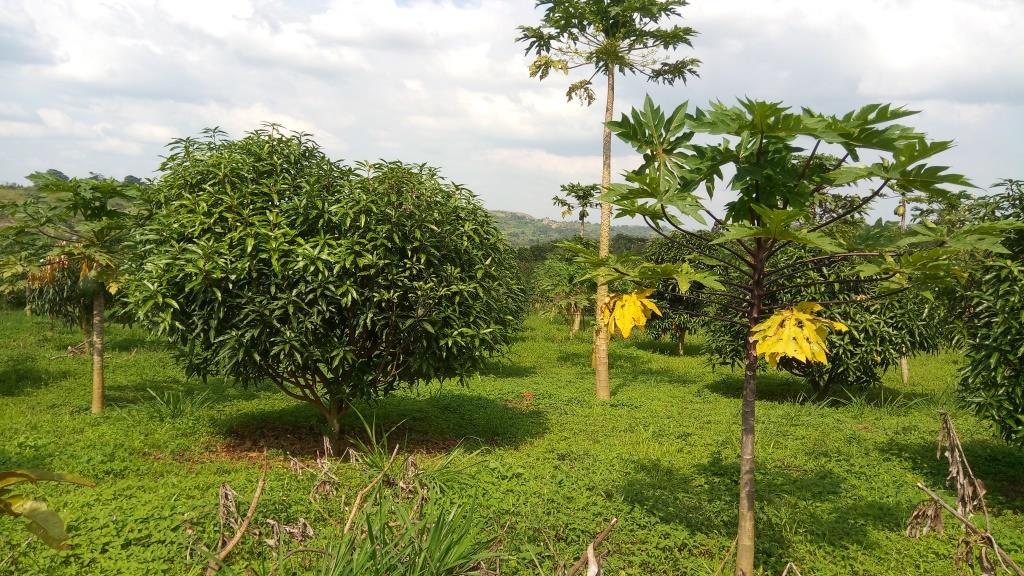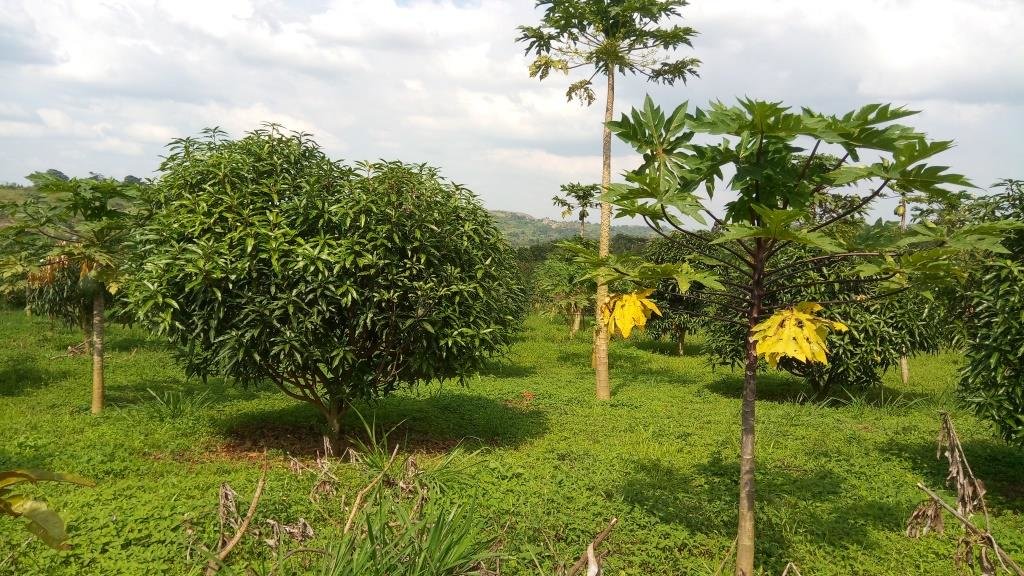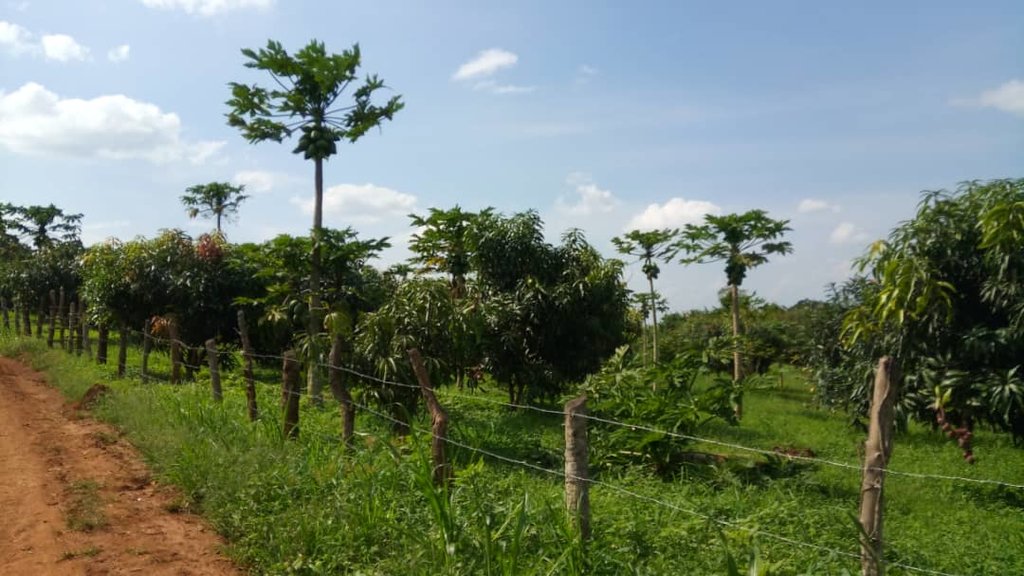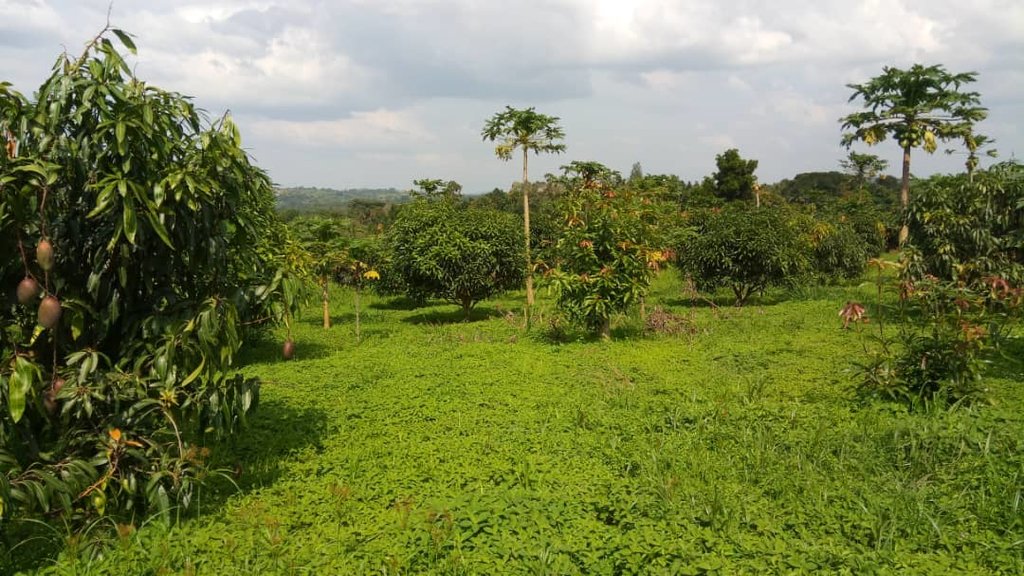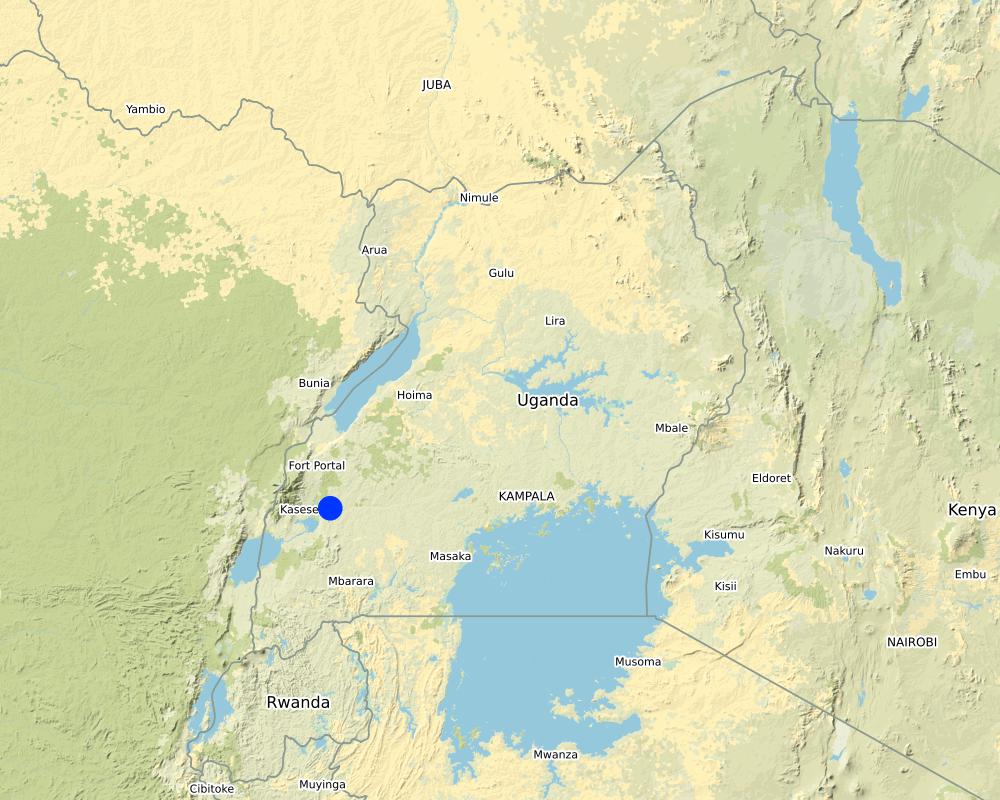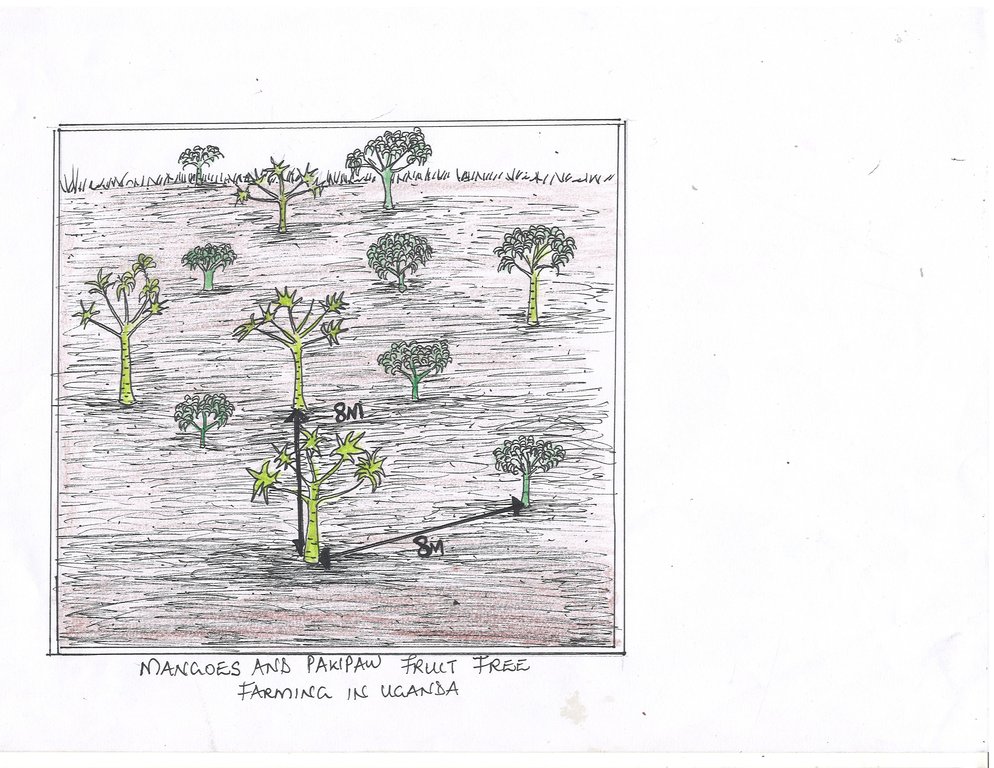Mango and paw-paw fruit tree growing [Ouganda]
- Création :
- Mise à jour :
- Compilateur : PRISCILLA VIVIAN KYOSABA
- Rédacteur : Kamugisha Rick Nelson
- Examinateurs : Nicole Harari, Udo Höggel
Okuliima emiyembe ahamwe namapapali
technologies_3302 - Ouganda
Voir les sections
Développer tout Réduire tout1. Informations générales
1.2 Coordonnées des personnes-ressources et des institutions impliquées dans l'évaluation et la documentation de la Technologie
Personne(s)-ressource(s) clé(s)
exploitant des terres:
Yusufu Rev Tinkasimire
KYEGEGWA TOWN COUNCIL
Ouganda
Nom du projet qui a facilité la documentation/ l'évaluation de la Technologie (si pertinent)
Scaling-up SLM practices by smallholder farmers (IFAD)Nom du ou des institutions qui ont facilité la documentation/ l'évaluation de la Technologie (si pertinent)
National Agricultural Research Organisation (NARO) - Ouganda1.3 Conditions relatives à l'utilisation par WOCAT des données documentées
Quand les données ont-elles été compilées (sur le terrain)?
14/11/2017
Le compilateur et la(les) personne(s) ressource(s) acceptent les conditions relatives à l'utilisation par WOCAT des données documentées:
Oui
1.4 Déclaration sur la durabilité de la Technologie décrite
Est-ce que la Technologie décrite ici pose problème par rapport à la dégradation des terres, de telle sorte qu'elle ne peut pas être déclarée comme étant une technologie de gestion durable des terres?
Non
2. Description de la Technologie de GDT
2.1 Courte description de la Technologie
Définition de la Technologie:
Fruit growing is one of the important and high paying branches of horticulture that involves planting of improved mango (mangifera indica) and paw paw (carica papaya)varieties in rows, with pawpaws(carica papaya) planted in between the mango(mangifera) trees with the aim of obtaining fruits for sale for income and environmental conservation.
2.2 Description détaillée de la Technologie
Description:
Mangoes (mangifera indica) integrated with pawpaw (carica papaya) on farm is a sustainable land management practice promoted by farmers in Kyeggwa District with the aim of producing for commercial purposes and soil fertility improvement. It is normally established on a one acre piece of land individually owned by the farmer. The varieties grown are mainly high breed grafted tree in nature that were supplied to the farmer by the area local government project aimed at scaling up fruit farming and eradication of poverty among the farming community.
The fruit tree farm is normally established on a gentle sloping area. In this area, due to over-cultivation, the soils where previously exposed to both wind and water erosion and degradation by heavy sunshine especially during the dry season. To address this, the farmer allowed weeds to grow under the trees which he slashed and left them to work as mulch material that protected the soils from erosion, moisture loss and fertility boost. Establishment of the plantation started with designation and enclosure of the area with a barbed wire to protect the establishments from free grazing goats and cattle, playing children and thieves. This was followed by clearing of shrubs and grasses, making of planting basins of dimensions 2×2 feet and application of manure a month prior to the planting of seedlings. The basin is made at a spacing of 8×8 meters from each other and on planting an alternating mango to pawpaw tree pattern is established in the garden. Shrub sticks are then used to build an enclosure around the fruit seedlings to further protect it from intruders that may pass through the barbed wire fence. Maintenance activities are quite laborious and recurrent, they include; daily irrigation of the seedlings in the dry season until they are a meter plus, spraying of insecticides and fungi on a weekly basis, pruning, harvesting and weeding. The activities are recurrent and require the farmer to employ two men to aid on the farm. The farmer faces challenges of snakes, rodents and birds that eat the fruits and therefore he needs to be always on alert when harvesting fruits.
Establishment costs per acre of the orchard is relatively expensive, one hundred sixty (160) mangoes and pawpaw tree seedlings valued at USD 123.2 where supplied to the farmer by local government for planting. The following activities were done to set up the technology:
- 4 men for the to fencing work,
- Clearing the land
- Preparing planting basins
- Planting the seedling which took them 5 days,
- Purchasing manure 20 sacks all those costed USD 304.3.
The maintenance activities, done at the farm include applying insecticides and fungicides on a weekly basis plus ring weeding.
The farm is maintained at average cost of USD 410.9 up to the fruiting stage, beyond which a well grown mango tree plant on harvest produces averagely between sixty (60) and eighty (80) mango fruits whereas for the pawpaw it produces between 20 and 30 respectively. This earns the farmer close to USD 1183 each harvest of the two seasons in the year which is significantly worth the farmer’s efforts.
2.3 Photos de la Technologie
2.4 Vidéos de la Technologie
Commentaire, brève description:
Mangoes (mangifera indica) and paw-paws (carica papaya) field.
Date:
14/11/2017
Lieu:
Kyegegwa District
2.5 Pays/ région/ lieux où la Technologie a été appliquée et qui sont couverts par cette évaluation
Pays:
Ouganda
Région/ Etat/ Province:
Western Region
Autres spécifications du lieu:
Kyegegwa town
Map
×2.6 Date de mise en œuvre de la Technologie
Indiquez l'année de mise en œuvre:
2013
2.7 Introduction de la Technologie
Spécifiez comment la Technologie a été introduite: :
- par le biais de projets/ d'interventions extérieures
Commentaires (type de projet, etc.) :
The farmer owning this fruit tree farm acquired both the knowledge and fruit tree seedlings from District local gorvernment that was working in partnership with National Agriculture Advisory Services (NAADS)
3. Classification de la Technologie de GDT
3.1 Principal(aux) objectif(s) de la Technologie
- créer un impact économique positif
- créer un impact social positif
3.2 Type(s) actuel(s) d'utilisation des terres, là où la Technologie est appliquée
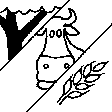
Mixte (cultures/ pâturages/ arbres), incluant l'agroforesterie
- Horticulture
3.3 Informations complémentaires sur l'utilisation des terres
Approvisionnement en eau des terres sur lesquelles est appliquée la Technologie:
- pluvial
Nombre de période de croissance par an: :
- 2
3.4 Groupe de GDT auquel appartient la Technologie
- perturbation minimale du sol
- amélioration des variétés végétales, des races animales
3.5 Diffusion de la Technologie
Spécifiez la diffusion de la Technologie:
- appliquée en des points spécifiques ou concentrée sur une petite surface
3.6 Mesures de GDT constituant la Technologie

pratiques végétales
- V1: Couverture d’arbres et d’arbustes
3.8 Prévention, réduction de la dégradation ou réhabilitation des terres dégradées
Spécifiez l'objectif de la Technologie au regard de la dégradation des terres:
- non applicable
4. Spécifications techniques, activités, intrants et coûts de mise en œuvre
4.1 Dessin technique de la Technologie
4.2 Spécification/ explications techniques du dessin technique
1 acre of fruit trees planted.
The field area is 80*50M
Spacing between the trees is 8*8 meters
Tree plant basin size is 2*2 feet.
The fruit farm is on a gentle slope
4.3 Informations générales sur le calcul des intrants et des coûts
Spécifiez la manière dont les coûts et les intrants ont été calculés:
- par entité de la Technologie
Précisez l'unité:
1 acre
Indiquez la monnaie utilisée pour le calcul des coûts:
- dollars US
Indiquer le taux de change du dollars en monnaie locale (si pertinent): 1 USD= :
3650,0
Indiquez le coût salarial moyen de la main d'œuvre par jour:
42900
4.4 Activités de mise en place/ d'établissement
| Activité | Type de mesures | Calendrier | |
|---|---|---|---|
| 1. | Clearing the land | Modes de gestion | Once |
| 2. | Digging plant basins | Autres mesures | Once |
| 3. | Apply manure in the established plant basins | Autres mesures | Once |
| 4. | Plant the seedlings | Modes de gestion | Once |
4.5 Coûts et intrants nécessaires à la mise en place
| Spécifiez les intrants | Unité | Quantité | Coûts par unité | Coût total par intrant | % du coût supporté par les exploitants des terres | |
|---|---|---|---|---|---|---|
| Main d'œuvre | Clearing the land | Man acre | 5,0 | 60000,0 | 300000,0 | 100,0 |
| Main d'œuvre | Digging plant basins and planting | Man acre | 5,0 | 90000,0 | 450000,0 | 100,0 |
| Matériel végétal | Fruit tree seedlings | Seedlings | 160,0 | 2000,0 | 320000,0 | |
| Engrais et biocides | Organic manure application | Sacks | 20,0 | 18000,0 | 360000,0 | 100,0 |
| Coût total de mise en place de la Technologie | 1430000,0 | |||||
4.6 Activités d'entretien/ récurrentes
| Activité | Type de mesures | Calendrier/ fréquence | |
|---|---|---|---|
| 1. | Weeding | Modes de gestion | Monthly |
| 2. | Spraying | Modes de gestion | After two weeks |
| 3. | Prunning | Modes de gestion | After three months |
| 4. | Fertilizer and manure application | Modes de gestion | Monthly |
4.7 Coûts et intrants nécessaires aux activités d'entretien/ récurrentes (par an)
Si possible, ventilez le coût de l'entretien selon le tableau suivant: spécifiez les intrants et le coût par intrant. Si vous n'êtes pas en mesure de ventiler le coût, donnez une estimation du coût total de l'entretien de la Technologie:
530000,0
Si le coût n'est pas pris en charge à 100% par l'exploitant des terres, indiquez qui a financé le coût restant:
A public organisation known as National Agriculture Advisory Services (NAADS) provided the farmer with fruit tree seedlings
Commentaires:
Maintenance activities cost estimated on a yearly basis
4.8 Facteurs les plus importants affectant les coûts
Décrivez les facteurs les plus importants affectant les coûts :
The equipment's and materials needed for establishment plus maintenance are relatively expensive
5. Environnement naturel et humain
5.1 Climat
Précipitations annuelles
- < 250 mm
- 251-500 mm
- 501-750 mm
- 751-1000 mm
- 1001-1500 mm
- 1501-2000 mm
- 2001-3000 mm
- 3001-4000 mm
- > 4000 mm
Zone agro-climatique
- subhumide
5.2 Topographie
Pentes moyennes:
- plat (0-2 %)
- faible (3-5%)
- modéré (6-10%)
- onduleux (11-15%)
- vallonné (16-30%)
- raide (31-60%)
- très raide (>60%)
Reliefs:
- plateaux/ plaines
- crêtes
- flancs/ pentes de montagne
- flancs/ pentes de colline
- piémonts/ glacis (bas de pente)
- fonds de vallée/bas-fonds
Zones altitudinales:
- 0-100 m
- 101-500 m
- 501-1000 m
- 1001-1500 m
- 1501-2000 m
- 2001-2500 m
- 2501-3000 m
- 3001-4000 m
- > 4000 m
5.3 Sols
Profondeur moyenne du sol:
- très superficiel (0-20 cm)
- superficiel (21-50 cm)
- modérément profond (51-80 cm)
- profond (81-120 cm)
- très profond (>120 cm)
Texture du sol (de la couche arable):
- moyen (limoneux)
Texture du sol (> 20 cm sous la surface):
- moyen (limoneux)
Matière organique de la couche arable:
- moyen (1-3%)
5.4 Disponibilité et qualité de l'eau
Profondeur estimée de l’eau dans le sol:
< 5 m
Disponibilité de l’eau de surface:
moyenne
Qualité de l’eau (non traitée):
eau potable
La salinité de l'eau est-elle un problème? :
Non
La zone est-elle inondée?
Non
5.5 Biodiversité
Diversité des espèces:
- moyenne
Diversité des habitats:
- moyenne
5.6 Caractéristiques des exploitants des terres appliquant la Technologie
Orientation du système de production:
- mixte (de subsistance/ commercial)
Revenus hors exploitation:
- moins de 10% de tous les revenus
Niveau relatif de richesse:
- moyen
Individus ou groupes:
- individu/ ménage
Niveau de mécanisation:
- travail manuel
Age des exploitants des terres:
- personnes âgées
5.7 Superficie moyenne des terres détenues ou louées par les exploitants appliquant la Technologie
- < 0,5 ha
- 0,5-1 ha
- 1-2 ha
- 2-5 ha
- 5-15 ha
- 15-50 ha
- 50-100 ha
- 100-500 ha
- 500-1 000 ha
- 1 000-10 000 ha
- > 10 000 ha
Cette superficie est-elle considérée comme de petite, moyenne ou grande dimension (en se référant au contexte local)?
- petite dimension
5.8 Propriété foncière, droits d’utilisation des terres et de l'eau
Propriété foncière:
- individu, sans titre de propriété
Droits d’utilisation des terres:
- individuel
Droits d’utilisation de l’eau:
- individuel
5.9 Accès aux services et aux infrastructures
santé:
- pauvre
- modéré
- bonne
éducation:
- pauvre
- modéré
- bonne
assistance technique:
- pauvre
- modéré
- bonne
emploi (par ex. hors exploitation):
- pauvre
- modéré
- bonne
marchés:
- pauvre
- modéré
- bonne
énergie:
- pauvre
- modéré
- bonne
routes et transports:
- pauvre
- modéré
- bonne
eau potable et assainissement:
- pauvre
- modéré
- bonne
services financiers:
- pauvre
- modéré
- bonne
6. Impacts et conclusions
6.1 Impacts sur site que la Technologie a montrés
Impacts socio-économiques
Revenus et coûts
revenus agricoles
Commentaires/ spécifiez:
With this practice the farmer reported getting income of 6 millions from the two harvest seasons in a year which is high compared to the 2 million he uses to raise from growing beans and maize annually
Impacts socioculturels
sécurité alimentaire/ autosuffisance
Commentaires/ spécifiez:
Farmer earns income from selling fruits from his garden. Therefore he does not sell his crop produce, saves it for food.
situation sanitaire
Commentaires/ spécifiez:
Farmer says he harvest and consumes a fruit on daily basis hence improving his and family's health status.
Impacts écologiques
Réduction des risques de catastrophe et des risques climatiques
impacts de la sécheresse
Commentaires/ spécifiez:
Underneath the trees is a permanent soil cover which maintains soil moisture enabling trees to resist drought.
6.2 Impacts hors site que la Technologie a montrés
envasement en aval
6.3 Exposition et sensibilité de la Technologie aux changements progressifs et aux évènements extrêmes/catastrophes liés au climat (telles que perçues par les exploitants des terres)
Changements climatiques progressifs
Changements climatiques progressifs
| Saison | Type de changements/ extrêmes climatiques | Comment la Technologie fait-elle face à cela? | |
|---|---|---|---|
| températures annuelles | décroît | modérément | |
| températures saisonnières | saison des pluies/ humide | décroît | modérément |
| précipitations annuelles | augmente | modérément | |
| précipitations saisonnières | saison des pluies/ humide | augmente | modérément |
Extrêmes climatiques (catastrophes)
Catastrophes météorologiques
| Comment la Technologie fait-elle face à cela? | |
|---|---|
| averse de grêle locale | très bien |
Catastrophes climatiques
| Comment la Technologie fait-elle face à cela? | |
|---|---|
| sécheresse | bien |
Catastrophes biologiques
| Comment la Technologie fait-elle face à cela? | |
|---|---|
| infestation par des insectes/ vers | modérément |
Commentaires:
Beneath the trees is a permanent cover of grass which enhances soil moisture retention enabling the trees to survive drought. The trees have a huge canopy which acts as a soil cover improving soil moisture retention.
6.4 Analyse coûts-bénéfices
Quels sont les bénéfices comparativement aux coûts de mise en place (du point de vue des exploitants des terres)?
Rentabilité à court terme:
négative
Rentabilité à long terme:
légèrement positive
Quels sont les bénéfices comparativement aux coûts d'entretien récurrents (du point de vue des exploitants des terres)?
Rentabilité à court terme:
légèrement positive
Rentabilité à long terme:
positive
6.5 Adoption de la Technologie
- 1-10%
Parmi tous ceux qui ont adopté la Technologie, combien d'entre eux l'ont fait spontanément, à savoir sans recevoir aucune incitation matérielle ou aucun paiement?
- 0-10%
6.6 Adaptation
La Technologie a-t-elle été récemment modifiée pour s'adapter à l'évolution des conditions?
Non
6.7 Points forts/ avantages/ possibilités de la Technologie
| Points forts/ avantages/ possibilités du point de vue de l'exploitant des terres |
|---|
| Serves as an employment opportunity for this farmer |
| Provide Income after sell of fruits to invest in sustainable land management practices |
| Can easily be replicated in other areas |
| Points forts/ avantages/ possibilités du point de vue du compilateur ou d'une autre personne ressource clé |
|---|
| Provide a large yield of fruit year after year for decades, requiring little human input when compared to the growing, planting, weeding, watering, pest control involved in annual vegetables. As a deep-rooted, long-lived perennial, the tree has time to adapt to local conditions and be more resilient. |
| Fruit tree orchards provide vital green spaces in our cities and towns, where people are encouraged to interact with nature either through becoming custodians of the trees or by simply being around them and enjoying their shade, beauty and fruit. |
6.8 Faiblesses/ inconvénients/ risques de la Technologie et moyens de les surmonter
| Faiblesses/ inconvénients/ risques du point de vue de l’exploitant des terres | Comment peuvent-ils être surmontés? |
|---|---|
| Relatively expensive to establish | Getting an organisation that can provide necessary equipment |
| Relatively expensive inputs for maintenance | District production office taking initiative to provide maintenance inputs like spraying pesticides at an affordable price |
| Ready fruits are bought cheaply sometime | Having an association for fruit growers that way fair prices can be set that favors all the farmers |
| Faiblesses/ inconvénients/ risques du point de vue du compilateur ou d'une autre personne ressource clé | Comment peuvent-ils être surmontés? |
|---|---|
| Relatively expensive to maintain; requires much capital to buy seedlings and pesticides | Access credit and pay after harvest |
| Much labor force required for establishment and maintaining | Form fruit growing groups and use group labour |
| It is very harmful to the environment – Intensive fruit farming usually involves the use of highly concentrated liquid fertilizers and a lot of deadly chemicals. These often find their way into the surrounding environment through rainwater runoff, where they wreak havoc on sensitive plants and animals | Promote use of organic fertiliser which is cheap and locally obtained |
7. Références et liens
7.1 Méthodes/ sources d'information
- interviews/entretiens avec les exploitants des terres
1
7.2 Références des publications disponibles
Titre, auteur, année, ISBN:
Li, Zongyu, "Perception of Risk and Risk Management in Fruit and Vegetable Marketing in Tennessee: The Case of Product Liability Risk. " Master's Thesis, University of Tennessee, 2014
Disponible à partir d'où? Coût?
Research Gate
7.3 Liens vers les informations pertinentes disponibles en ligne
Titre/ description:
Benefits of orchards and fruit growing
URL:
https://www.theorchardproject.org.uk/guides_and_advice/benefits-of-orchards-and-fruit-growing/
Titre/ description:
Production risks
URL:
https://www.researchgate.net/figure/Production-risks-in-farming-of-fruits-and-vegetables_tbl5_227365161
Titre/ description:
Risk Management
URL:
Agricultural, Food and the Environment
Liens et modules
Développer tout Réduire toutLiens
Aucun lien
Modules
Aucun module trouvé


